McDonald's Singapore: Strategic Analysis Using PESTLE and Porter's
VerifiedAdded on 2023/06/12
|11
|3465
|207
Report
AI Summary
This report provides an external environmental analysis of McDonald's in Singapore using the PESTLE and Porter's Five Forces frameworks. It describes McDonald's operations, analyzes political, economic, social, technological, environmental, and legal factors affecting the company, and assesses competitive rivalry, bargaining power of buyers and suppliers, threat of substitutes, and threat of new entrants. The report identifies key issues such as competition from other fast-food chains and the impact of health regulations. It concludes with management recommendations for McDonald's to maintain its market position and improve its strategies in the Singaporean market, focusing on adapting to market demands and catering to customer preferences.
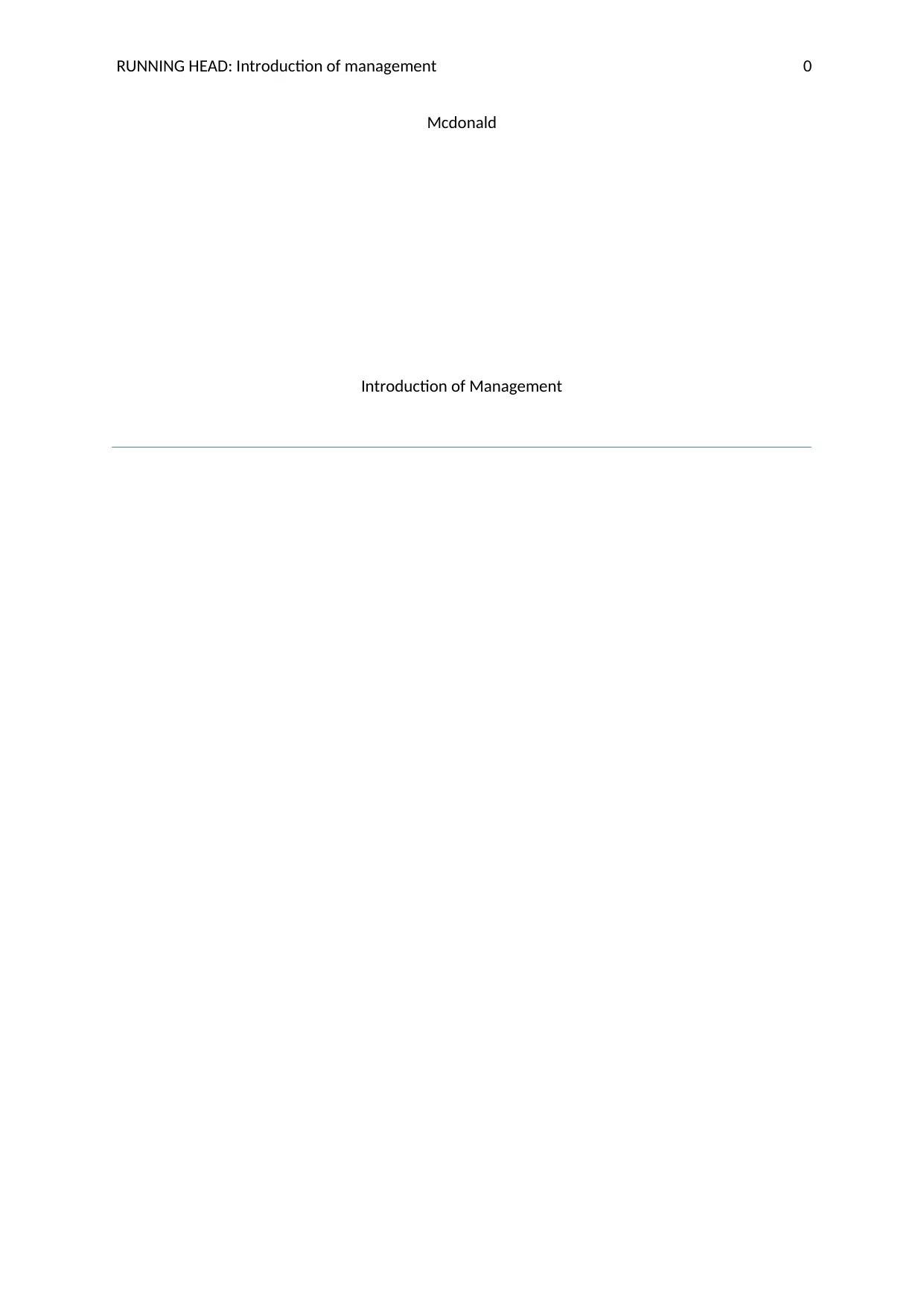
RUNNING HEAD: Introduction of management 0
Mcdonald
Introduction of Management
Mcdonald
Introduction of Management
Paraphrase This Document
Need a fresh take? Get an instant paraphrase of this document with our AI Paraphraser
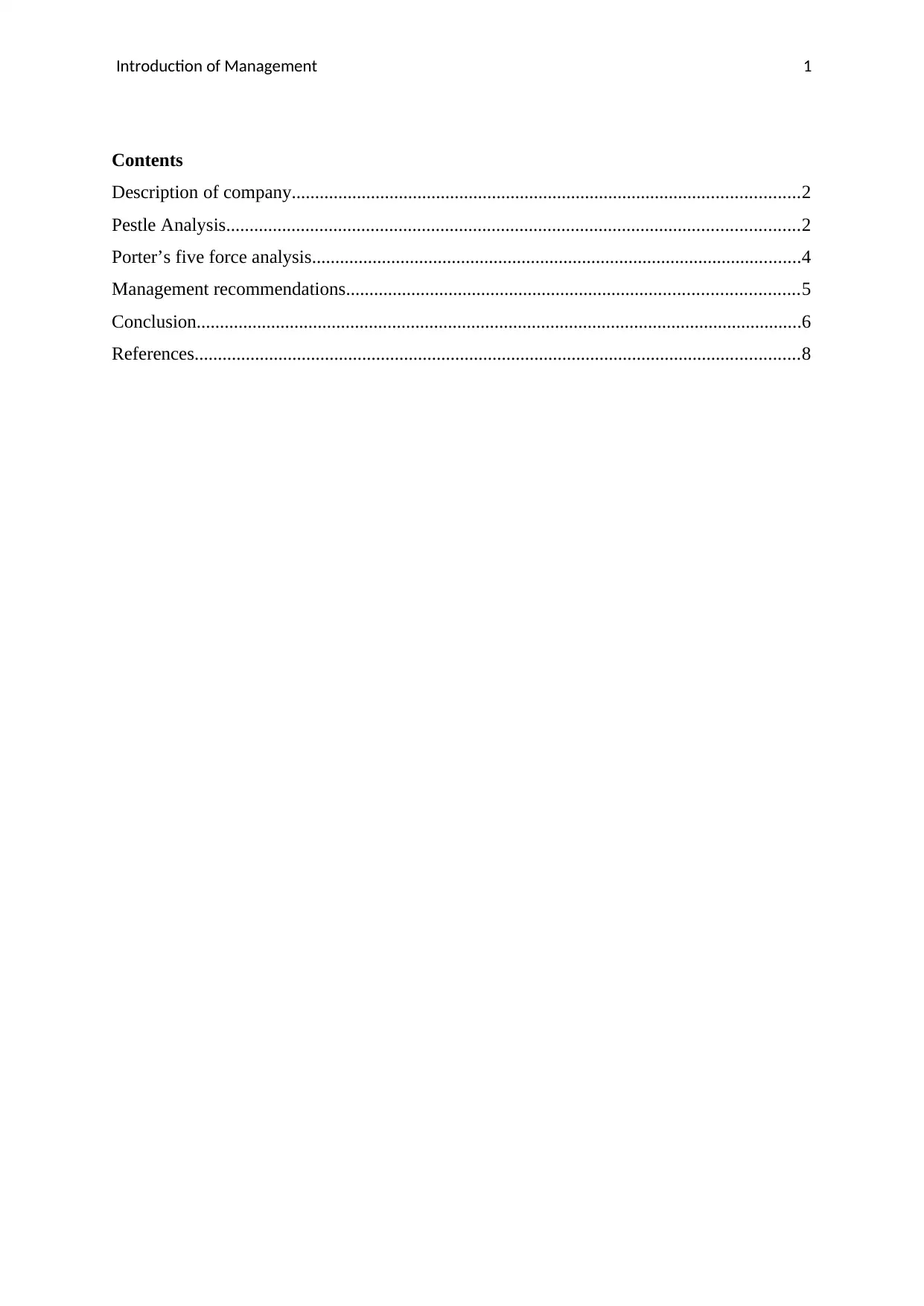
Introduction of Management 1
Contents
Description of company.............................................................................................................2
Pestle Analysis...........................................................................................................................2
Porter’s five force analysis.........................................................................................................4
Management recommendations.................................................................................................5
Conclusion..................................................................................................................................6
References..................................................................................................................................8
Contents
Description of company.............................................................................................................2
Pestle Analysis...........................................................................................................................2
Porter’s five force analysis.........................................................................................................4
Management recommendations.................................................................................................5
Conclusion..................................................................................................................................6
References..................................................................................................................................8
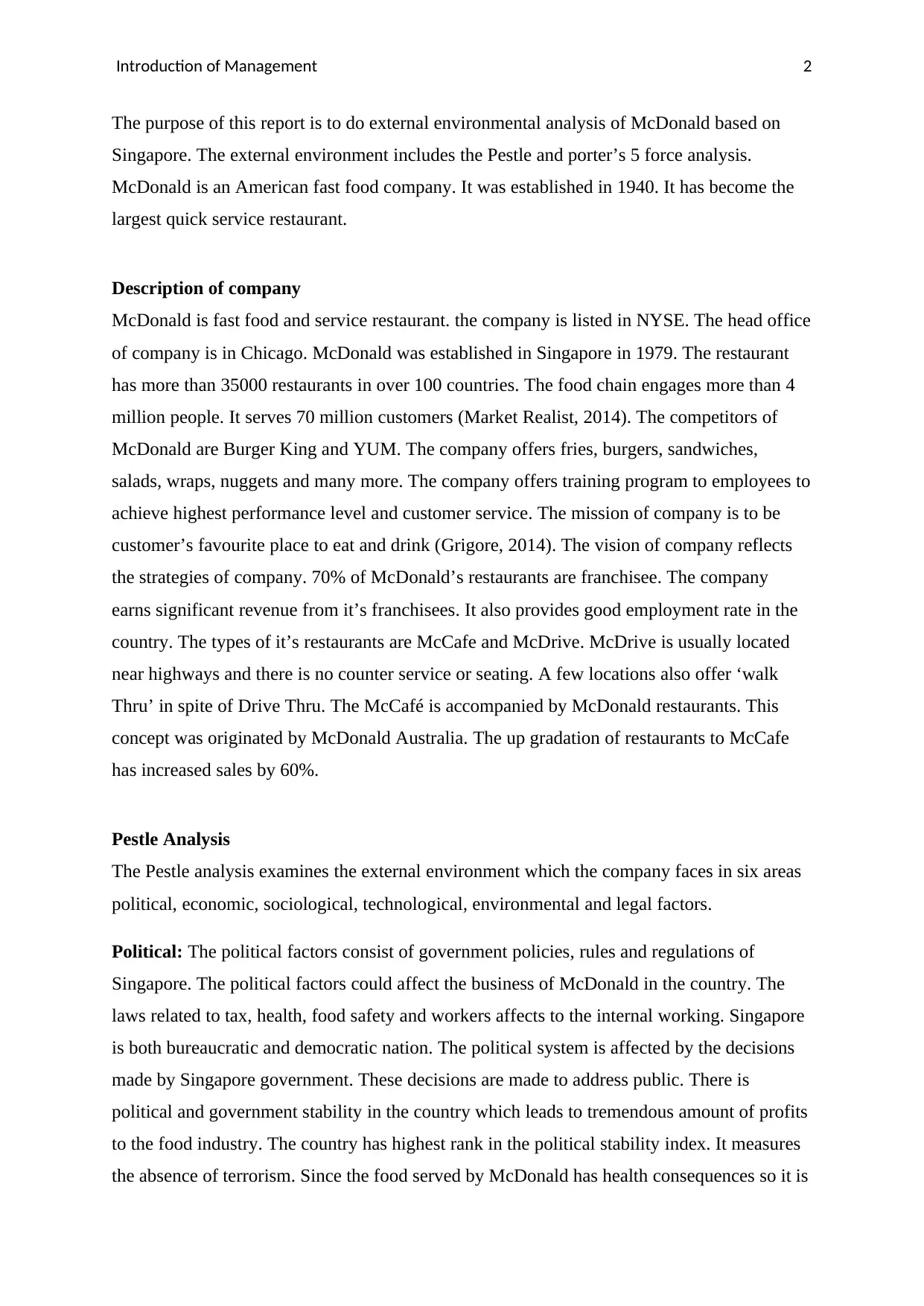
Introduction of Management 2
The purpose of this report is to do external environmental analysis of McDonald based on
Singapore. The external environment includes the Pestle and porter’s 5 force analysis.
McDonald is an American fast food company. It was established in 1940. It has become the
largest quick service restaurant.
Description of company
McDonald is fast food and service restaurant. the company is listed in NYSE. The head office
of company is in Chicago. McDonald was established in Singapore in 1979. The restaurant
has more than 35000 restaurants in over 100 countries. The food chain engages more than 4
million people. It serves 70 million customers (Market Realist, 2014). The competitors of
McDonald are Burger King and YUM. The company offers fries, burgers, sandwiches,
salads, wraps, nuggets and many more. The company offers training program to employees to
achieve highest performance level and customer service. The mission of company is to be
customer’s favourite place to eat and drink (Grigore, 2014). The vision of company reflects
the strategies of company. 70% of McDonald’s restaurants are franchisee. The company
earns significant revenue from it’s franchisees. It also provides good employment rate in the
country. The types of it’s restaurants are McCafe and McDrive. McDrive is usually located
near highways and there is no counter service or seating. A few locations also offer ‘walk
Thru’ in spite of Drive Thru. The McCafé is accompanied by McDonald restaurants. This
concept was originated by McDonald Australia. The up gradation of restaurants to McCafe
has increased sales by 60%.
Pestle Analysis
The Pestle analysis examines the external environment which the company faces in six areas
political, economic, sociological, technological, environmental and legal factors.
Political: The political factors consist of government policies, rules and regulations of
Singapore. The political factors could affect the business of McDonald in the country. The
laws related to tax, health, food safety and workers affects to the internal working. Singapore
is both bureaucratic and democratic nation. The political system is affected by the decisions
made by Singapore government. These decisions are made to address public. There is
political and government stability in the country which leads to tremendous amount of profits
to the food industry. The country has highest rank in the political stability index. It measures
the absence of terrorism. Since the food served by McDonald has health consequences so it is
The purpose of this report is to do external environmental analysis of McDonald based on
Singapore. The external environment includes the Pestle and porter’s 5 force analysis.
McDonald is an American fast food company. It was established in 1940. It has become the
largest quick service restaurant.
Description of company
McDonald is fast food and service restaurant. the company is listed in NYSE. The head office
of company is in Chicago. McDonald was established in Singapore in 1979. The restaurant
has more than 35000 restaurants in over 100 countries. The food chain engages more than 4
million people. It serves 70 million customers (Market Realist, 2014). The competitors of
McDonald are Burger King and YUM. The company offers fries, burgers, sandwiches,
salads, wraps, nuggets and many more. The company offers training program to employees to
achieve highest performance level and customer service. The mission of company is to be
customer’s favourite place to eat and drink (Grigore, 2014). The vision of company reflects
the strategies of company. 70% of McDonald’s restaurants are franchisee. The company
earns significant revenue from it’s franchisees. It also provides good employment rate in the
country. The types of it’s restaurants are McCafe and McDrive. McDrive is usually located
near highways and there is no counter service or seating. A few locations also offer ‘walk
Thru’ in spite of Drive Thru. The McCafé is accompanied by McDonald restaurants. This
concept was originated by McDonald Australia. The up gradation of restaurants to McCafe
has increased sales by 60%.
Pestle Analysis
The Pestle analysis examines the external environment which the company faces in six areas
political, economic, sociological, technological, environmental and legal factors.
Political: The political factors consist of government policies, rules and regulations of
Singapore. The political factors could affect the business of McDonald in the country. The
laws related to tax, health, food safety and workers affects to the internal working. Singapore
is both bureaucratic and democratic nation. The political system is affected by the decisions
made by Singapore government. These decisions are made to address public. There is
political and government stability in the country which leads to tremendous amount of profits
to the food industry. The country has highest rank in the political stability index. It measures
the absence of terrorism. Since the food served by McDonald has health consequences so it is
⊘ This is a preview!⊘
Do you want full access?
Subscribe today to unlock all pages.

Trusted by 1+ million students worldwide
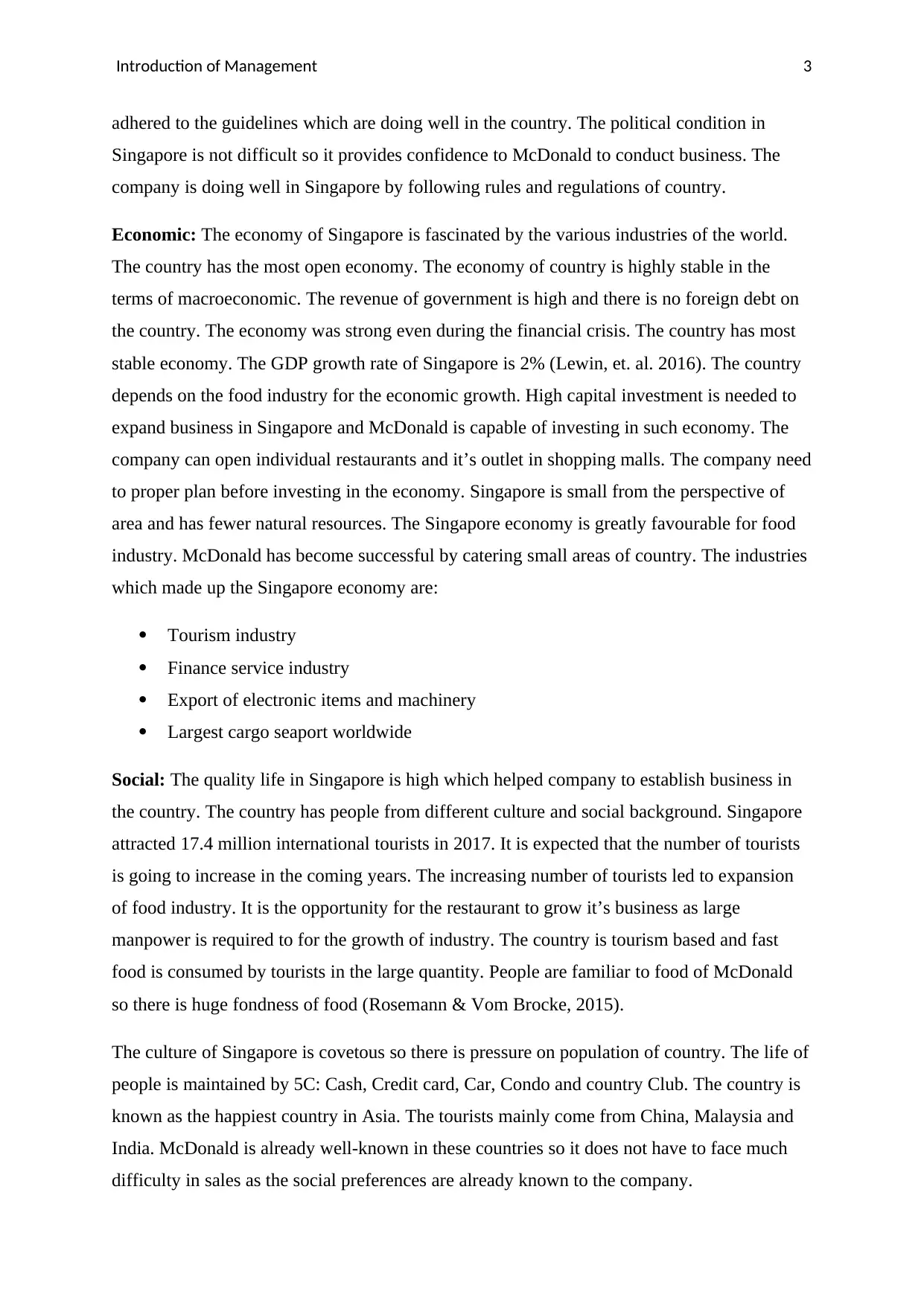
Introduction of Management 3
adhered to the guidelines which are doing well in the country. The political condition in
Singapore is not difficult so it provides confidence to McDonald to conduct business. The
company is doing well in Singapore by following rules and regulations of country.
Economic: The economy of Singapore is fascinated by the various industries of the world.
The country has the most open economy. The economy of country is highly stable in the
terms of macroeconomic. The revenue of government is high and there is no foreign debt on
the country. The economy was strong even during the financial crisis. The country has most
stable economy. The GDP growth rate of Singapore is 2% (Lewin, et. al. 2016). The country
depends on the food industry for the economic growth. High capital investment is needed to
expand business in Singapore and McDonald is capable of investing in such economy. The
company can open individual restaurants and it’s outlet in shopping malls. The company need
to proper plan before investing in the economy. Singapore is small from the perspective of
area and has fewer natural resources. The Singapore economy is greatly favourable for food
industry. McDonald has become successful by catering small areas of country. The industries
which made up the Singapore economy are:
Tourism industry
Finance service industry
Export of electronic items and machinery
Largest cargo seaport worldwide
Social: The quality life in Singapore is high which helped company to establish business in
the country. The country has people from different culture and social background. Singapore
attracted 17.4 million international tourists in 2017. It is expected that the number of tourists
is going to increase in the coming years. The increasing number of tourists led to expansion
of food industry. It is the opportunity for the restaurant to grow it’s business as large
manpower is required to for the growth of industry. The country is tourism based and fast
food is consumed by tourists in the large quantity. People are familiar to food of McDonald
so there is huge fondness of food (Rosemann & Vom Brocke, 2015).
The culture of Singapore is covetous so there is pressure on population of country. The life of
people is maintained by 5C: Cash, Credit card, Car, Condo and country Club. The country is
known as the happiest country in Asia. The tourists mainly come from China, Malaysia and
India. McDonald is already well-known in these countries so it does not have to face much
difficulty in sales as the social preferences are already known to the company.
adhered to the guidelines which are doing well in the country. The political condition in
Singapore is not difficult so it provides confidence to McDonald to conduct business. The
company is doing well in Singapore by following rules and regulations of country.
Economic: The economy of Singapore is fascinated by the various industries of the world.
The country has the most open economy. The economy of country is highly stable in the
terms of macroeconomic. The revenue of government is high and there is no foreign debt on
the country. The economy was strong even during the financial crisis. The country has most
stable economy. The GDP growth rate of Singapore is 2% (Lewin, et. al. 2016). The country
depends on the food industry for the economic growth. High capital investment is needed to
expand business in Singapore and McDonald is capable of investing in such economy. The
company can open individual restaurants and it’s outlet in shopping malls. The company need
to proper plan before investing in the economy. Singapore is small from the perspective of
area and has fewer natural resources. The Singapore economy is greatly favourable for food
industry. McDonald has become successful by catering small areas of country. The industries
which made up the Singapore economy are:
Tourism industry
Finance service industry
Export of electronic items and machinery
Largest cargo seaport worldwide
Social: The quality life in Singapore is high which helped company to establish business in
the country. The country has people from different culture and social background. Singapore
attracted 17.4 million international tourists in 2017. It is expected that the number of tourists
is going to increase in the coming years. The increasing number of tourists led to expansion
of food industry. It is the opportunity for the restaurant to grow it’s business as large
manpower is required to for the growth of industry. The country is tourism based and fast
food is consumed by tourists in the large quantity. People are familiar to food of McDonald
so there is huge fondness of food (Rosemann & Vom Brocke, 2015).
The culture of Singapore is covetous so there is pressure on population of country. The life of
people is maintained by 5C: Cash, Credit card, Car, Condo and country Club. The country is
known as the happiest country in Asia. The tourists mainly come from China, Malaysia and
India. McDonald is already well-known in these countries so it does not have to face much
difficulty in sales as the social preferences are already known to the company.
Paraphrase This Document
Need a fresh take? Get an instant paraphrase of this document with our AI Paraphraser
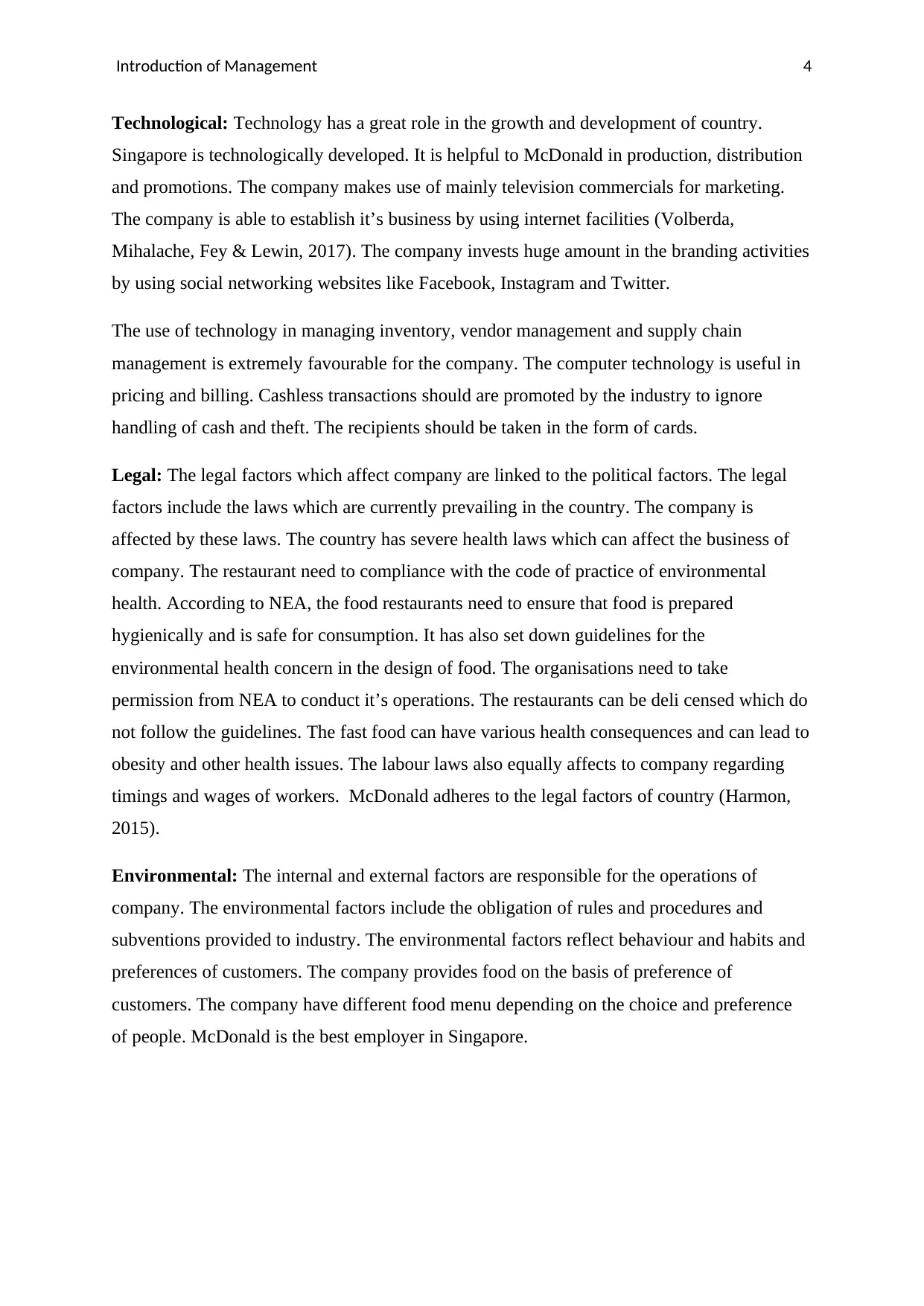
Introduction of Management 4
Technological: Technology has a great role in the growth and development of country.
Singapore is technologically developed. It is helpful to McDonald in production, distribution
and promotions. The company makes use of mainly television commercials for marketing.
The company is able to establish it’s business by using internet facilities (Volberda,
Mihalache, Fey & Lewin, 2017). The company invests huge amount in the branding activities
by using social networking websites like Facebook, Instagram and Twitter.
The use of technology in managing inventory, vendor management and supply chain
management is extremely favourable for the company. The computer technology is useful in
pricing and billing. Cashless transactions should are promoted by the industry to ignore
handling of cash and theft. The recipients should be taken in the form of cards.
Legal: The legal factors which affect company are linked to the political factors. The legal
factors include the laws which are currently prevailing in the country. The company is
affected by these laws. The country has severe health laws which can affect the business of
company. The restaurant need to compliance with the code of practice of environmental
health. According to NEA, the food restaurants need to ensure that food is prepared
hygienically and is safe for consumption. It has also set down guidelines for the
environmental health concern in the design of food. The organisations need to take
permission from NEA to conduct it’s operations. The restaurants can be deli censed which do
not follow the guidelines. The fast food can have various health consequences and can lead to
obesity and other health issues. The labour laws also equally affects to company regarding
timings and wages of workers. McDonald adheres to the legal factors of country (Harmon,
2015).
Environmental: The internal and external factors are responsible for the operations of
company. The environmental factors include the obligation of rules and procedures and
subventions provided to industry. The environmental factors reflect behaviour and habits and
preferences of customers. The company provides food on the basis of preference of
customers. The company have different food menu depending on the choice and preference
of people. McDonald is the best employer in Singapore.
Technological: Technology has a great role in the growth and development of country.
Singapore is technologically developed. It is helpful to McDonald in production, distribution
and promotions. The company makes use of mainly television commercials for marketing.
The company is able to establish it’s business by using internet facilities (Volberda,
Mihalache, Fey & Lewin, 2017). The company invests huge amount in the branding activities
by using social networking websites like Facebook, Instagram and Twitter.
The use of technology in managing inventory, vendor management and supply chain
management is extremely favourable for the company. The computer technology is useful in
pricing and billing. Cashless transactions should are promoted by the industry to ignore
handling of cash and theft. The recipients should be taken in the form of cards.
Legal: The legal factors which affect company are linked to the political factors. The legal
factors include the laws which are currently prevailing in the country. The company is
affected by these laws. The country has severe health laws which can affect the business of
company. The restaurant need to compliance with the code of practice of environmental
health. According to NEA, the food restaurants need to ensure that food is prepared
hygienically and is safe for consumption. It has also set down guidelines for the
environmental health concern in the design of food. The organisations need to take
permission from NEA to conduct it’s operations. The restaurants can be deli censed which do
not follow the guidelines. The fast food can have various health consequences and can lead to
obesity and other health issues. The labour laws also equally affects to company regarding
timings and wages of workers. McDonald adheres to the legal factors of country (Harmon,
2015).
Environmental: The internal and external factors are responsible for the operations of
company. The environmental factors include the obligation of rules and procedures and
subventions provided to industry. The environmental factors reflect behaviour and habits and
preferences of customers. The company provides food on the basis of preference of
customers. The company have different food menu depending on the choice and preference
of people. McDonald is the best employer in Singapore.
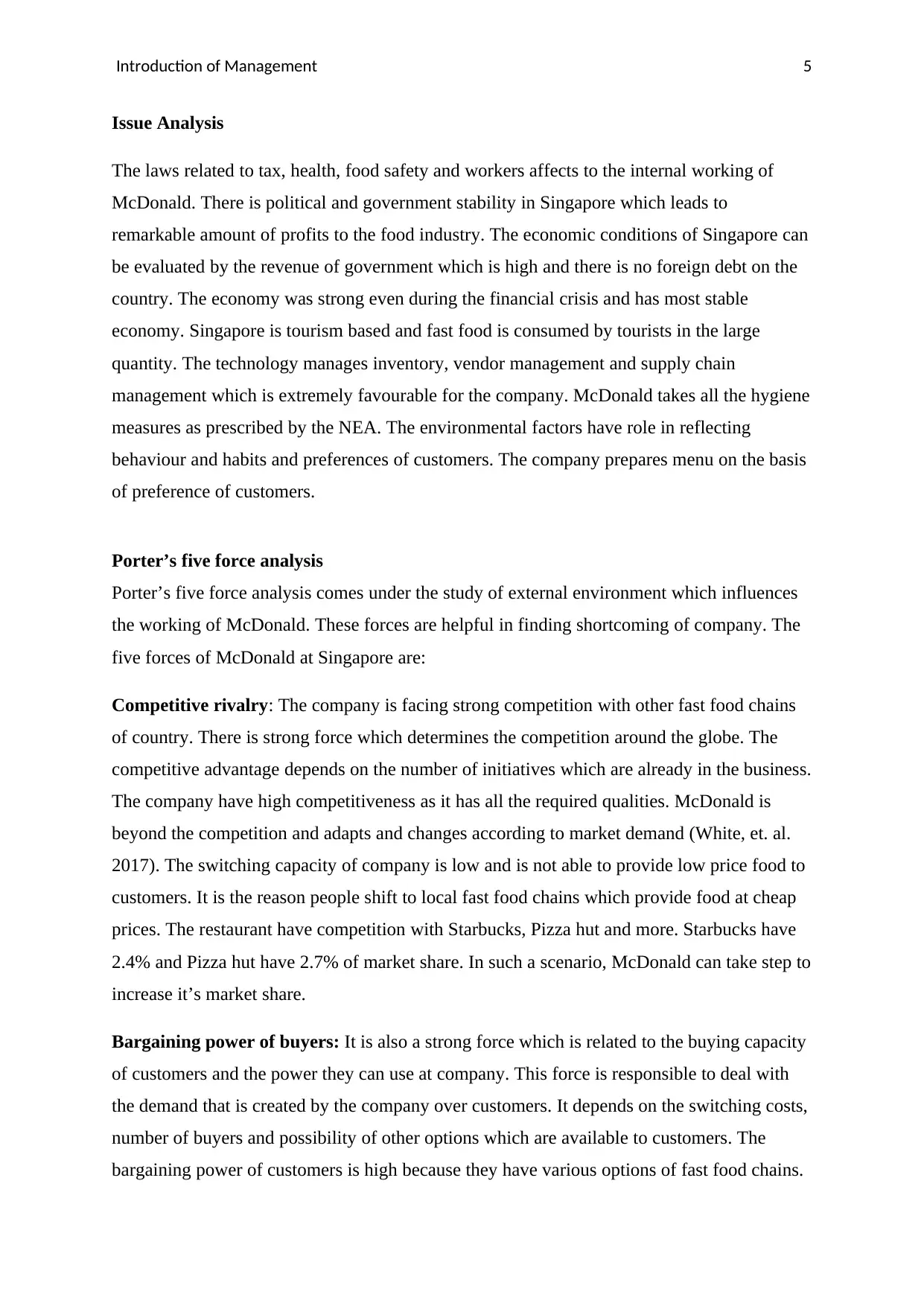
Introduction of Management 5
Issue Analysis
The laws related to tax, health, food safety and workers affects to the internal working of
McDonald. There is political and government stability in Singapore which leads to
remarkable amount of profits to the food industry. The economic conditions of Singapore can
be evaluated by the revenue of government which is high and there is no foreign debt on the
country. The economy was strong even during the financial crisis and has most stable
economy. Singapore is tourism based and fast food is consumed by tourists in the large
quantity. The technology manages inventory, vendor management and supply chain
management which is extremely favourable for the company. McDonald takes all the hygiene
measures as prescribed by the NEA. The environmental factors have role in reflecting
behaviour and habits and preferences of customers. The company prepares menu on the basis
of preference of customers.
Porter’s five force analysis
Porter’s five force analysis comes under the study of external environment which influences
the working of McDonald. These forces are helpful in finding shortcoming of company. The
five forces of McDonald at Singapore are:
Competitive rivalry: The company is facing strong competition with other fast food chains
of country. There is strong force which determines the competition around the globe. The
competitive advantage depends on the number of initiatives which are already in the business.
The company have high competitiveness as it has all the required qualities. McDonald is
beyond the competition and adapts and changes according to market demand (White, et. al.
2017). The switching capacity of company is low and is not able to provide low price food to
customers. It is the reason people shift to local fast food chains which provide food at cheap
prices. The restaurant have competition with Starbucks, Pizza hut and more. Starbucks have
2.4% and Pizza hut have 2.7% of market share. In such a scenario, McDonald can take step to
increase it’s market share.
Bargaining power of buyers: It is also a strong force which is related to the buying capacity
of customers and the power they can use at company. This force is responsible to deal with
the demand that is created by the company over customers. It depends on the switching costs,
number of buyers and possibility of other options which are available to customers. The
bargaining power of customers is high because they have various options of fast food chains.
Issue Analysis
The laws related to tax, health, food safety and workers affects to the internal working of
McDonald. There is political and government stability in Singapore which leads to
remarkable amount of profits to the food industry. The economic conditions of Singapore can
be evaluated by the revenue of government which is high and there is no foreign debt on the
country. The economy was strong even during the financial crisis and has most stable
economy. Singapore is tourism based and fast food is consumed by tourists in the large
quantity. The technology manages inventory, vendor management and supply chain
management which is extremely favourable for the company. McDonald takes all the hygiene
measures as prescribed by the NEA. The environmental factors have role in reflecting
behaviour and habits and preferences of customers. The company prepares menu on the basis
of preference of customers.
Porter’s five force analysis
Porter’s five force analysis comes under the study of external environment which influences
the working of McDonald. These forces are helpful in finding shortcoming of company. The
five forces of McDonald at Singapore are:
Competitive rivalry: The company is facing strong competition with other fast food chains
of country. There is strong force which determines the competition around the globe. The
competitive advantage depends on the number of initiatives which are already in the business.
The company have high competitiveness as it has all the required qualities. McDonald is
beyond the competition and adapts and changes according to market demand (White, et. al.
2017). The switching capacity of company is low and is not able to provide low price food to
customers. It is the reason people shift to local fast food chains which provide food at cheap
prices. The restaurant have competition with Starbucks, Pizza hut and more. Starbucks have
2.4% and Pizza hut have 2.7% of market share. In such a scenario, McDonald can take step to
increase it’s market share.
Bargaining power of buyers: It is also a strong force which is related to the buying capacity
of customers and the power they can use at company. This force is responsible to deal with
the demand that is created by the company over customers. It depends on the switching costs,
number of buyers and possibility of other options which are available to customers. The
bargaining power of customers is high because they have various options of fast food chains.
⊘ This is a preview!⊘
Do you want full access?
Subscribe today to unlock all pages.

Trusted by 1+ million students worldwide
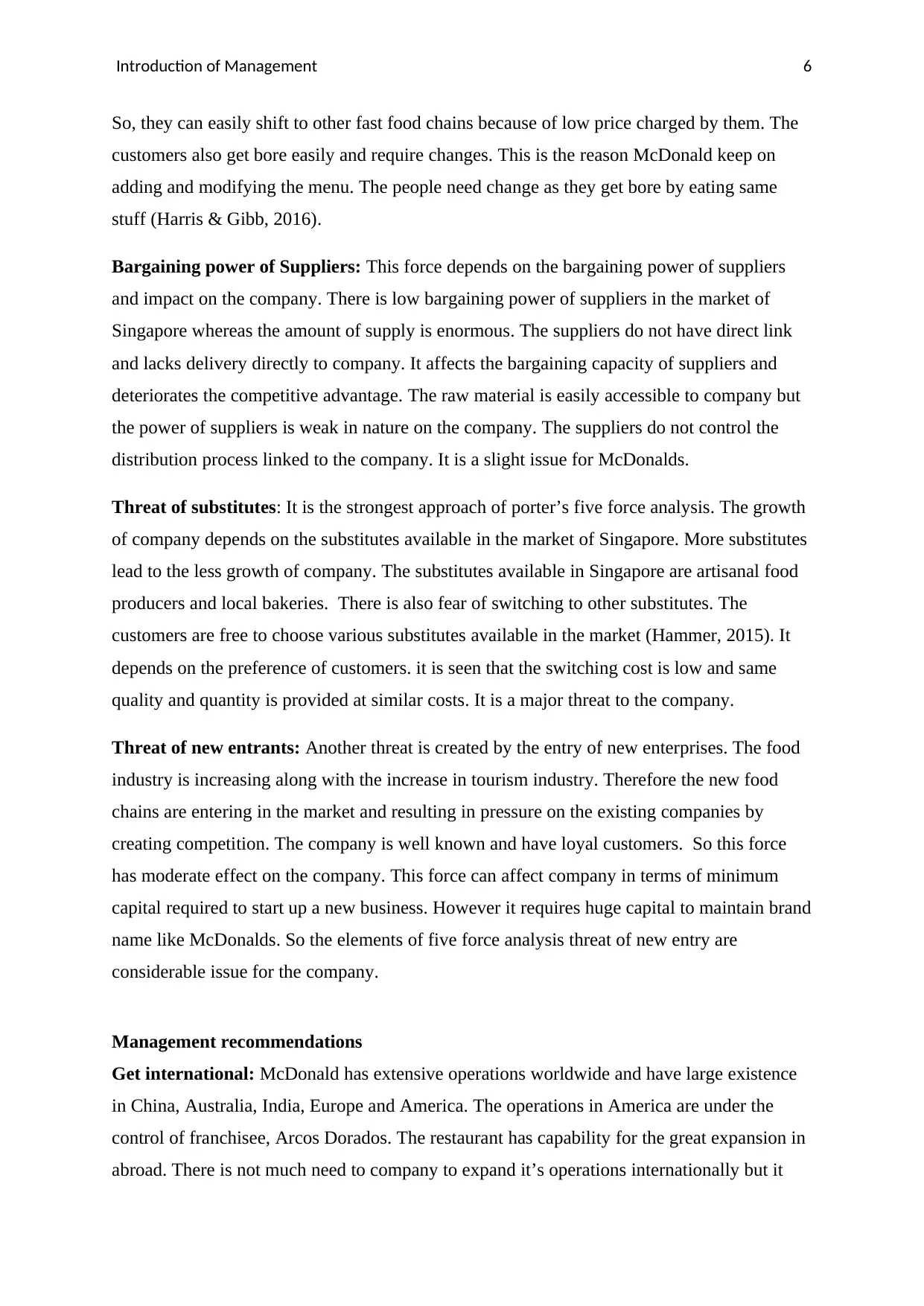
Introduction of Management 6
So, they can easily shift to other fast food chains because of low price charged by them. The
customers also get bore easily and require changes. This is the reason McDonald keep on
adding and modifying the menu. The people need change as they get bore by eating same
stuff (Harris & Gibb, 2016).
Bargaining power of Suppliers: This force depends on the bargaining power of suppliers
and impact on the company. There is low bargaining power of suppliers in the market of
Singapore whereas the amount of supply is enormous. The suppliers do not have direct link
and lacks delivery directly to company. It affects the bargaining capacity of suppliers and
deteriorates the competitive advantage. The raw material is easily accessible to company but
the power of suppliers is weak in nature on the company. The suppliers do not control the
distribution process linked to the company. It is a slight issue for McDonalds.
Threat of substitutes: It is the strongest approach of porter’s five force analysis. The growth
of company depends on the substitutes available in the market of Singapore. More substitutes
lead to the less growth of company. The substitutes available in Singapore are artisanal food
producers and local bakeries. There is also fear of switching to other substitutes. The
customers are free to choose various substitutes available in the market (Hammer, 2015). It
depends on the preference of customers. it is seen that the switching cost is low and same
quality and quantity is provided at similar costs. It is a major threat to the company.
Threat of new entrants: Another threat is created by the entry of new enterprises. The food
industry is increasing along with the increase in tourism industry. Therefore the new food
chains are entering in the market and resulting in pressure on the existing companies by
creating competition. The company is well known and have loyal customers. So this force
has moderate effect on the company. This force can affect company in terms of minimum
capital required to start up a new business. However it requires huge capital to maintain brand
name like McDonalds. So the elements of five force analysis threat of new entry are
considerable issue for the company.
Management recommendations
Get international: McDonald has extensive operations worldwide and have large existence
in China, Australia, India, Europe and America. The operations in America are under the
control of franchisee, Arcos Dorados. The restaurant has capability for the great expansion in
abroad. There is not much need to company to expand it’s operations internationally but it
So, they can easily shift to other fast food chains because of low price charged by them. The
customers also get bore easily and require changes. This is the reason McDonald keep on
adding and modifying the menu. The people need change as they get bore by eating same
stuff (Harris & Gibb, 2016).
Bargaining power of Suppliers: This force depends on the bargaining power of suppliers
and impact on the company. There is low bargaining power of suppliers in the market of
Singapore whereas the amount of supply is enormous. The suppliers do not have direct link
and lacks delivery directly to company. It affects the bargaining capacity of suppliers and
deteriorates the competitive advantage. The raw material is easily accessible to company but
the power of suppliers is weak in nature on the company. The suppliers do not control the
distribution process linked to the company. It is a slight issue for McDonalds.
Threat of substitutes: It is the strongest approach of porter’s five force analysis. The growth
of company depends on the substitutes available in the market of Singapore. More substitutes
lead to the less growth of company. The substitutes available in Singapore are artisanal food
producers and local bakeries. There is also fear of switching to other substitutes. The
customers are free to choose various substitutes available in the market (Hammer, 2015). It
depends on the preference of customers. it is seen that the switching cost is low and same
quality and quantity is provided at similar costs. It is a major threat to the company.
Threat of new entrants: Another threat is created by the entry of new enterprises. The food
industry is increasing along with the increase in tourism industry. Therefore the new food
chains are entering in the market and resulting in pressure on the existing companies by
creating competition. The company is well known and have loyal customers. So this force
has moderate effect on the company. This force can affect company in terms of minimum
capital required to start up a new business. However it requires huge capital to maintain brand
name like McDonalds. So the elements of five force analysis threat of new entry are
considerable issue for the company.
Management recommendations
Get international: McDonald has extensive operations worldwide and have large existence
in China, Australia, India, Europe and America. The operations in America are under the
control of franchisee, Arcos Dorados. The restaurant has capability for the great expansion in
abroad. There is not much need to company to expand it’s operations internationally but it
Paraphrase This Document
Need a fresh take? Get an instant paraphrase of this document with our AI Paraphraser
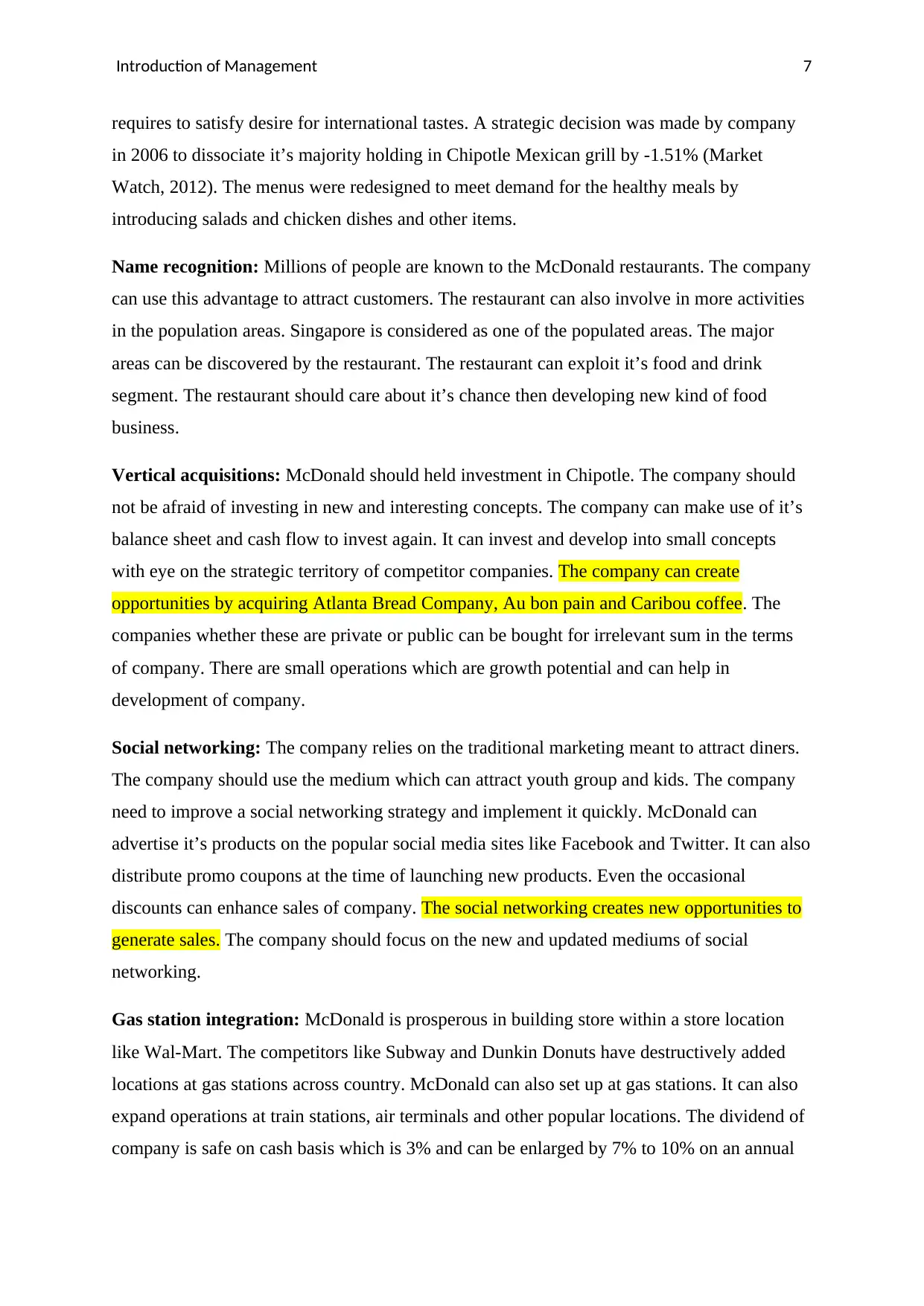
Introduction of Management 7
requires to satisfy desire for international tastes. A strategic decision was made by company
in 2006 to dissociate it’s majority holding in Chipotle Mexican grill by -1.51% (Market
Watch, 2012). The menus were redesigned to meet demand for the healthy meals by
introducing salads and chicken dishes and other items.
Name recognition: Millions of people are known to the McDonald restaurants. The company
can use this advantage to attract customers. The restaurant can also involve in more activities
in the population areas. Singapore is considered as one of the populated areas. The major
areas can be discovered by the restaurant. The restaurant can exploit it’s food and drink
segment. The restaurant should care about it’s chance then developing new kind of food
business.
Vertical acquisitions: McDonald should held investment in Chipotle. The company should
not be afraid of investing in new and interesting concepts. The company can make use of it’s
balance sheet and cash flow to invest again. It can invest and develop into small concepts
with eye on the strategic territory of competitor companies. The company can create
opportunities by acquiring Atlanta Bread Company, Au bon pain and Caribou coffee. The
companies whether these are private or public can be bought for irrelevant sum in the terms
of company. There are small operations which are growth potential and can help in
development of company.
Social networking: The company relies on the traditional marketing meant to attract diners.
The company should use the medium which can attract youth group and kids. The company
need to improve a social networking strategy and implement it quickly. McDonald can
advertise it’s products on the popular social media sites like Facebook and Twitter. It can also
distribute promo coupons at the time of launching new products. Even the occasional
discounts can enhance sales of company. The social networking creates new opportunities to
generate sales. The company should focus on the new and updated mediums of social
networking.
Gas station integration: McDonald is prosperous in building store within a store location
like Wal-Mart. The competitors like Subway and Dunkin Donuts have destructively added
locations at gas stations across country. McDonald can also set up at gas stations. It can also
expand operations at train stations, air terminals and other popular locations. The dividend of
company is safe on cash basis which is 3% and can be enlarged by 7% to 10% on an annual
requires to satisfy desire for international tastes. A strategic decision was made by company
in 2006 to dissociate it’s majority holding in Chipotle Mexican grill by -1.51% (Market
Watch, 2012). The menus were redesigned to meet demand for the healthy meals by
introducing salads and chicken dishes and other items.
Name recognition: Millions of people are known to the McDonald restaurants. The company
can use this advantage to attract customers. The restaurant can also involve in more activities
in the population areas. Singapore is considered as one of the populated areas. The major
areas can be discovered by the restaurant. The restaurant can exploit it’s food and drink
segment. The restaurant should care about it’s chance then developing new kind of food
business.
Vertical acquisitions: McDonald should held investment in Chipotle. The company should
not be afraid of investing in new and interesting concepts. The company can make use of it’s
balance sheet and cash flow to invest again. It can invest and develop into small concepts
with eye on the strategic territory of competitor companies. The company can create
opportunities by acquiring Atlanta Bread Company, Au bon pain and Caribou coffee. The
companies whether these are private or public can be bought for irrelevant sum in the terms
of company. There are small operations which are growth potential and can help in
development of company.
Social networking: The company relies on the traditional marketing meant to attract diners.
The company should use the medium which can attract youth group and kids. The company
need to improve a social networking strategy and implement it quickly. McDonald can
advertise it’s products on the popular social media sites like Facebook and Twitter. It can also
distribute promo coupons at the time of launching new products. Even the occasional
discounts can enhance sales of company. The social networking creates new opportunities to
generate sales. The company should focus on the new and updated mediums of social
networking.
Gas station integration: McDonald is prosperous in building store within a store location
like Wal-Mart. The competitors like Subway and Dunkin Donuts have destructively added
locations at gas stations across country. McDonald can also set up at gas stations. It can also
expand operations at train stations, air terminals and other popular locations. The dividend of
company is safe on cash basis which is 3% and can be enlarged by 7% to 10% on an annual
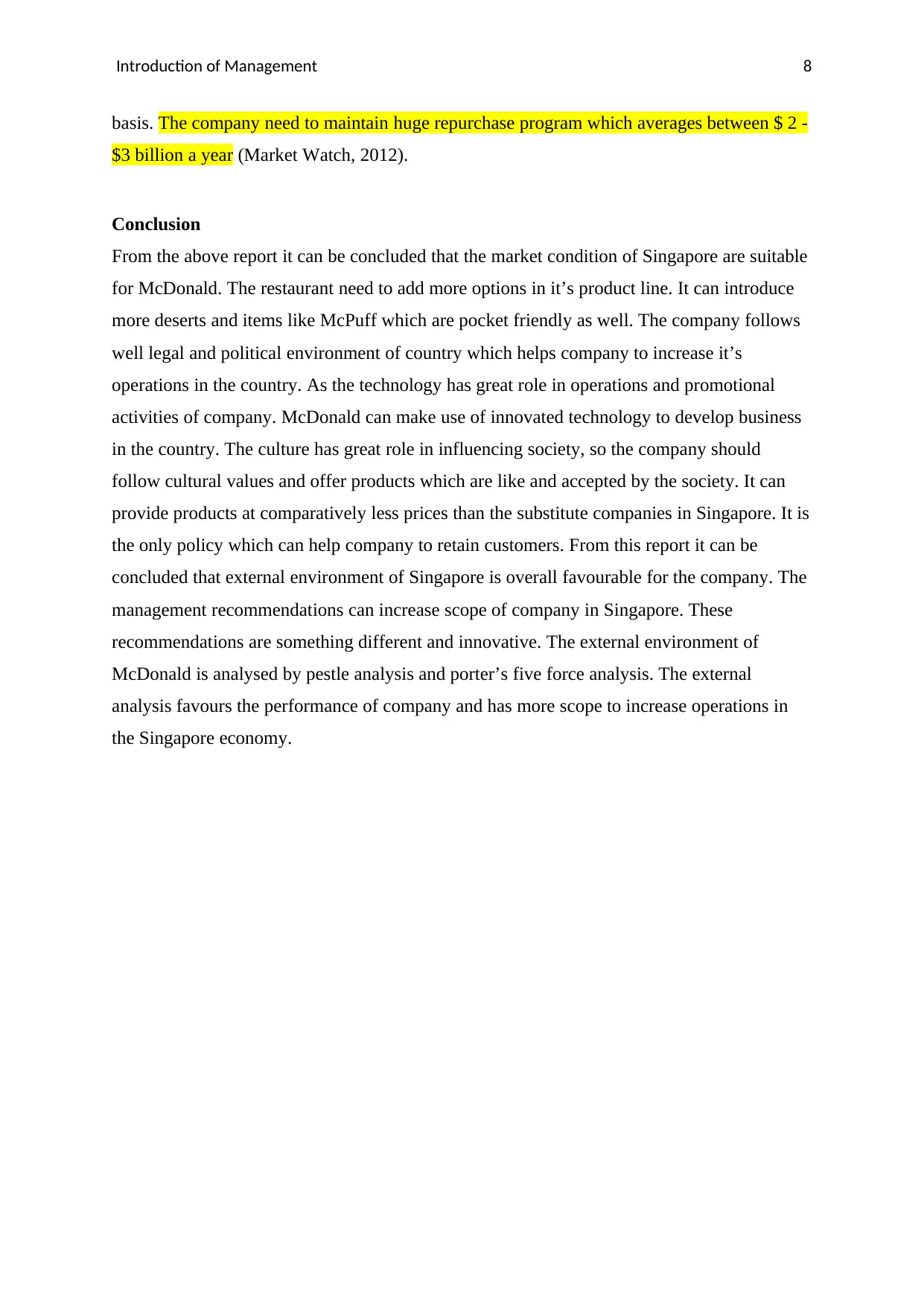
Introduction of Management 8
basis. The company need to maintain huge repurchase program which averages between $ 2 -
$3 billion a year (Market Watch, 2012).
Conclusion
From the above report it can be concluded that the market condition of Singapore are suitable
for McDonald. The restaurant need to add more options in it’s product line. It can introduce
more deserts and items like McPuff which are pocket friendly as well. The company follows
well legal and political environment of country which helps company to increase it’s
operations in the country. As the technology has great role in operations and promotional
activities of company. McDonald can make use of innovated technology to develop business
in the country. The culture has great role in influencing society, so the company should
follow cultural values and offer products which are like and accepted by the society. It can
provide products at comparatively less prices than the substitute companies in Singapore. It is
the only policy which can help company to retain customers. From this report it can be
concluded that external environment of Singapore is overall favourable for the company. The
management recommendations can increase scope of company in Singapore. These
recommendations are something different and innovative. The external environment of
McDonald is analysed by pestle analysis and porter’s five force analysis. The external
analysis favours the performance of company and has more scope to increase operations in
the Singapore economy.
basis. The company need to maintain huge repurchase program which averages between $ 2 -
$3 billion a year (Market Watch, 2012).
Conclusion
From the above report it can be concluded that the market condition of Singapore are suitable
for McDonald. The restaurant need to add more options in it’s product line. It can introduce
more deserts and items like McPuff which are pocket friendly as well. The company follows
well legal and political environment of country which helps company to increase it’s
operations in the country. As the technology has great role in operations and promotional
activities of company. McDonald can make use of innovated technology to develop business
in the country. The culture has great role in influencing society, so the company should
follow cultural values and offer products which are like and accepted by the society. It can
provide products at comparatively less prices than the substitute companies in Singapore. It is
the only policy which can help company to retain customers. From this report it can be
concluded that external environment of Singapore is overall favourable for the company. The
management recommendations can increase scope of company in Singapore. These
recommendations are something different and innovative. The external environment of
McDonald is analysed by pestle analysis and porter’s five force analysis. The external
analysis favours the performance of company and has more scope to increase operations in
the Singapore economy.
⊘ This is a preview!⊘
Do you want full access?
Subscribe today to unlock all pages.

Trusted by 1+ million students worldwide
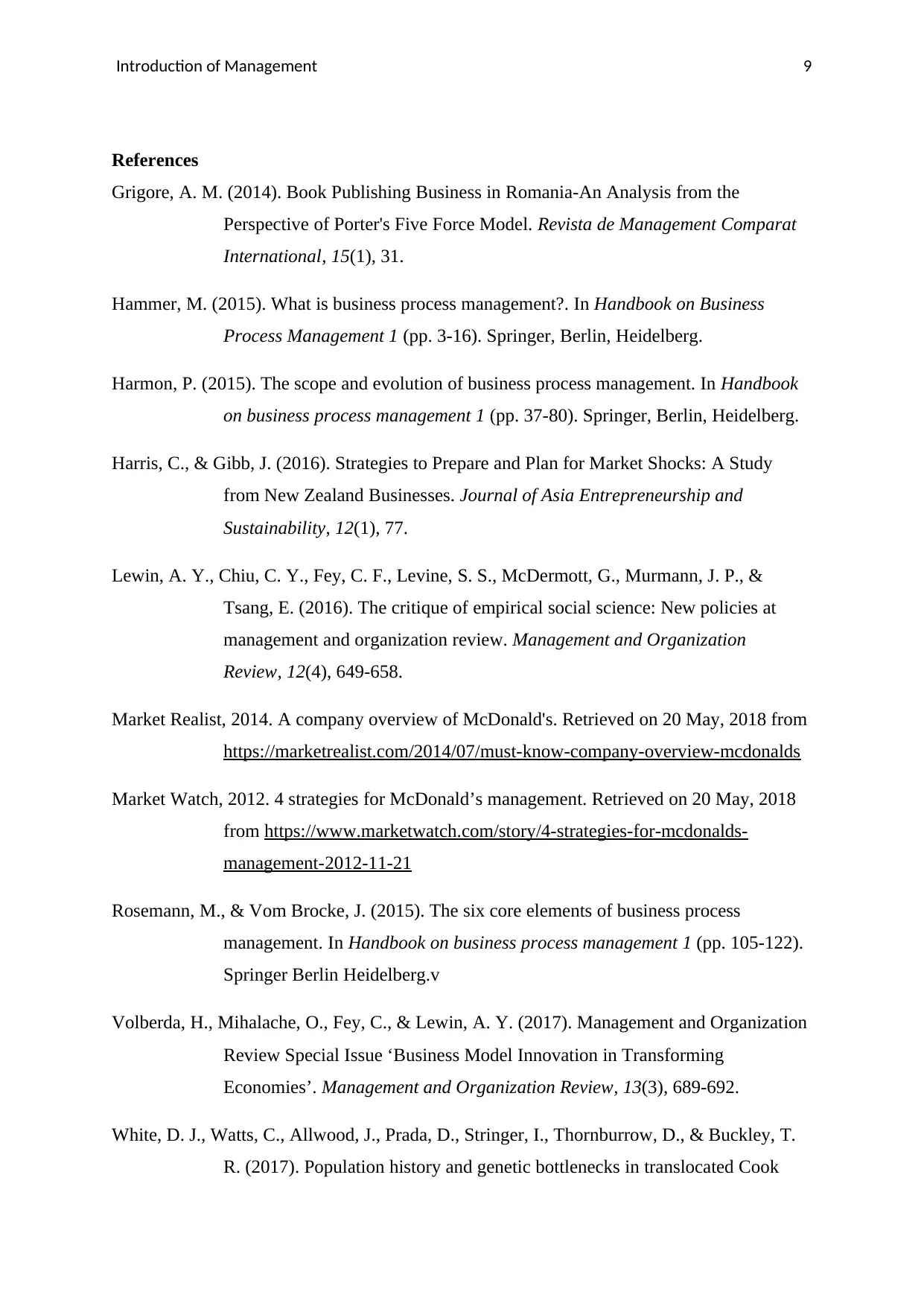
Introduction of Management 9
References
Grigore, A. M. (2014). Book Publishing Business in Romania-An Analysis from the
Perspective of Porter's Five Force Model. Revista de Management Comparat
International, 15(1), 31.
Hammer, M. (2015). What is business process management?. In Handbook on Business
Process Management 1 (pp. 3-16). Springer, Berlin, Heidelberg.
Harmon, P. (2015). The scope and evolution of business process management. In Handbook
on business process management 1 (pp. 37-80). Springer, Berlin, Heidelberg.
Harris, C., & Gibb, J. (2016). Strategies to Prepare and Plan for Market Shocks: A Study
from New Zealand Businesses. Journal of Asia Entrepreneurship and
Sustainability, 12(1), 77.
Lewin, A. Y., Chiu, C. Y., Fey, C. F., Levine, S. S., McDermott, G., Murmann, J. P., &
Tsang, E. (2016). The critique of empirical social science: New policies at
management and organization review. Management and Organization
Review, 12(4), 649-658.
Market Realist, 2014. A company overview of McDonald's. Retrieved on 20 May, 2018 from
https://marketrealist.com/2014/07/must-know-company-overview-mcdonalds
Market Watch, 2012. 4 strategies for McDonald’s management. Retrieved on 20 May, 2018
from https://www.marketwatch.com/story/4-strategies-for-mcdonalds-
management-2012-11-21
Rosemann, M., & Vom Brocke, J. (2015). The six core elements of business process
management. In Handbook on business process management 1 (pp. 105-122).
Springer Berlin Heidelberg.v
Volberda, H., Mihalache, O., Fey, C., & Lewin, A. Y. (2017). Management and Organization
Review Special Issue ‘Business Model Innovation in Transforming
Economies’. Management and Organization Review, 13(3), 689-692.
White, D. J., Watts, C., Allwood, J., Prada, D., Stringer, I., Thornburrow, D., & Buckley, T.
R. (2017). Population history and genetic bottlenecks in translocated Cook
References
Grigore, A. M. (2014). Book Publishing Business in Romania-An Analysis from the
Perspective of Porter's Five Force Model. Revista de Management Comparat
International, 15(1), 31.
Hammer, M. (2015). What is business process management?. In Handbook on Business
Process Management 1 (pp. 3-16). Springer, Berlin, Heidelberg.
Harmon, P. (2015). The scope and evolution of business process management. In Handbook
on business process management 1 (pp. 37-80). Springer, Berlin, Heidelberg.
Harris, C., & Gibb, J. (2016). Strategies to Prepare and Plan for Market Shocks: A Study
from New Zealand Businesses. Journal of Asia Entrepreneurship and
Sustainability, 12(1), 77.
Lewin, A. Y., Chiu, C. Y., Fey, C. F., Levine, S. S., McDermott, G., Murmann, J. P., &
Tsang, E. (2016). The critique of empirical social science: New policies at
management and organization review. Management and Organization
Review, 12(4), 649-658.
Market Realist, 2014. A company overview of McDonald's. Retrieved on 20 May, 2018 from
https://marketrealist.com/2014/07/must-know-company-overview-mcdonalds
Market Watch, 2012. 4 strategies for McDonald’s management. Retrieved on 20 May, 2018
from https://www.marketwatch.com/story/4-strategies-for-mcdonalds-
management-2012-11-21
Rosemann, M., & Vom Brocke, J. (2015). The six core elements of business process
management. In Handbook on business process management 1 (pp. 105-122).
Springer Berlin Heidelberg.v
Volberda, H., Mihalache, O., Fey, C., & Lewin, A. Y. (2017). Management and Organization
Review Special Issue ‘Business Model Innovation in Transforming
Economies’. Management and Organization Review, 13(3), 689-692.
White, D. J., Watts, C., Allwood, J., Prada, D., Stringer, I., Thornburrow, D., & Buckley, T.
R. (2017). Population history and genetic bottlenecks in translocated Cook
Paraphrase This Document
Need a fresh take? Get an instant paraphrase of this document with our AI Paraphraser
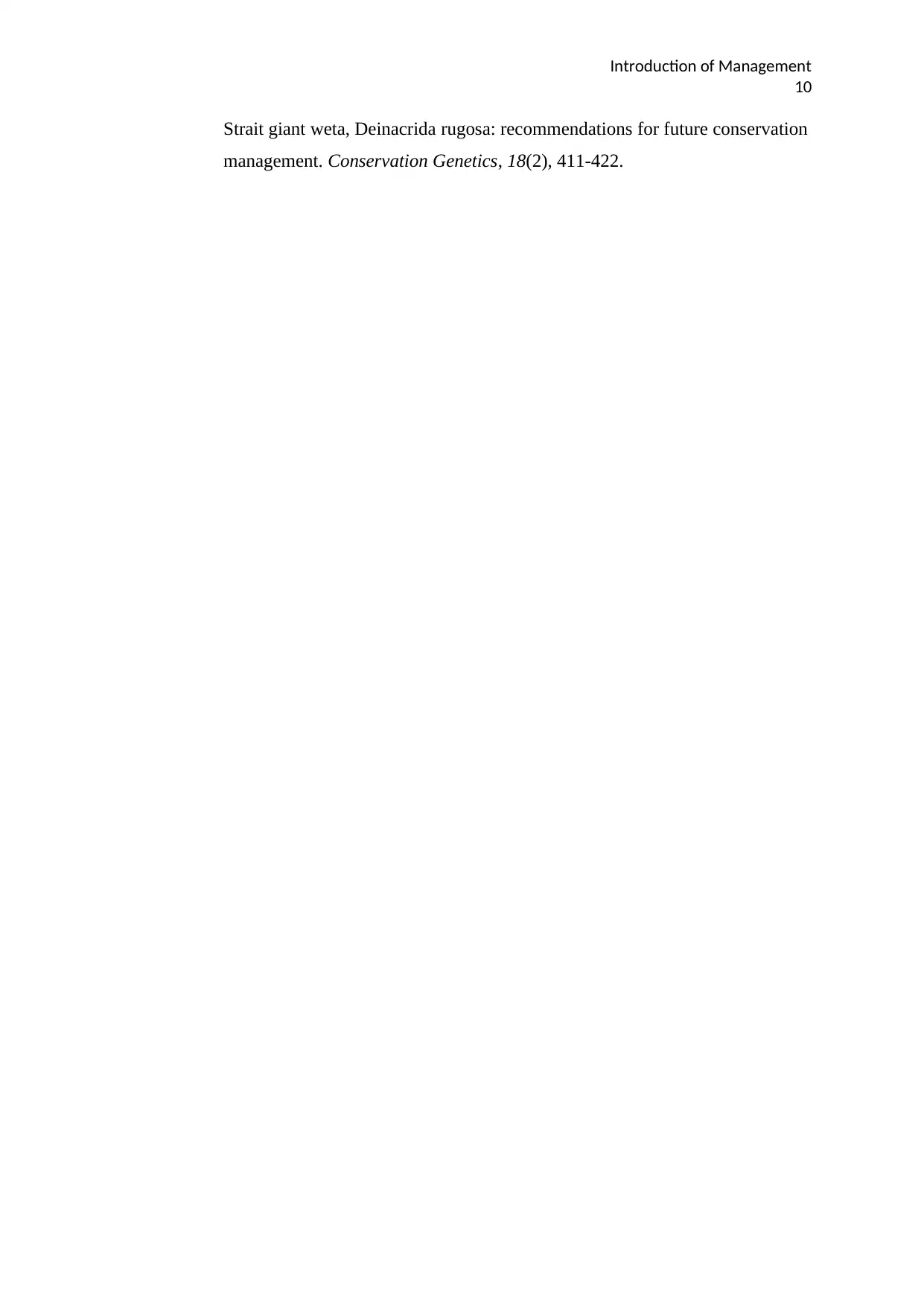
Introduction of Management
10
Strait giant weta, Deinacrida rugosa: recommendations for future conservation
management. Conservation Genetics, 18(2), 411-422.
10
Strait giant weta, Deinacrida rugosa: recommendations for future conservation
management. Conservation Genetics, 18(2), 411-422.
1 out of 11
Related Documents
Your All-in-One AI-Powered Toolkit for Academic Success.
+13062052269
info@desklib.com
Available 24*7 on WhatsApp / Email
![[object Object]](/_next/static/media/star-bottom.7253800d.svg)
Unlock your academic potential
Copyright © 2020–2025 A2Z Services. All Rights Reserved. Developed and managed by ZUCOL.





